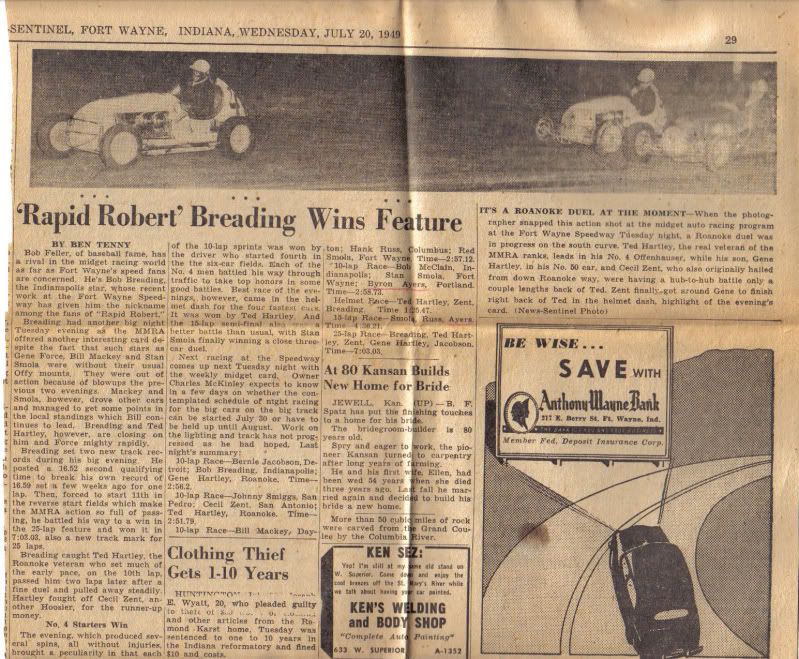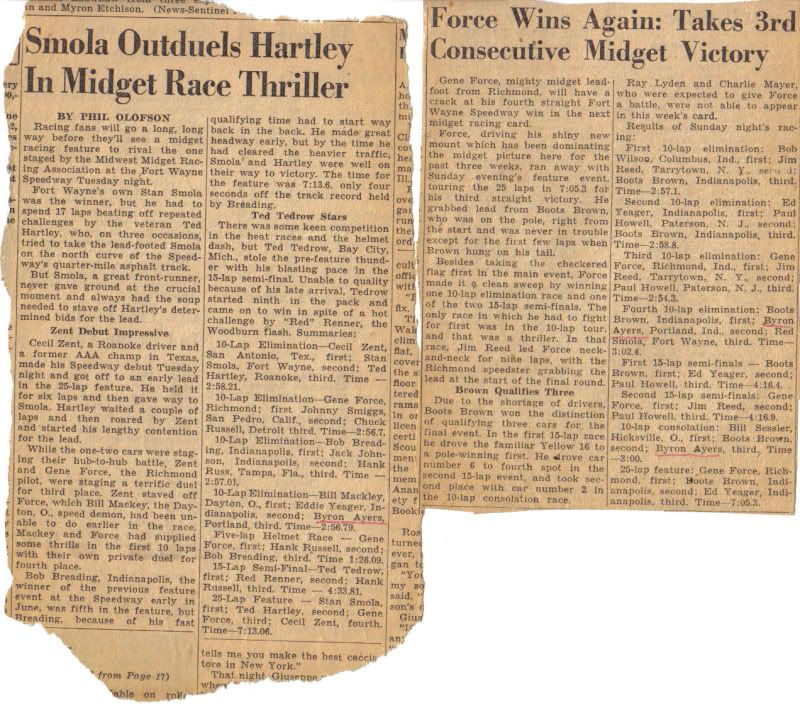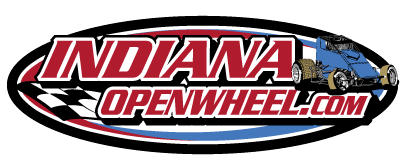| Home | Register | Quick Links | FAQ | Donate | Contact |
 Indiana Open Wheel
> Indiana Open Wheel Forum
>
Fort Wayne Speedway
Indiana Open Wheel
> Indiana Open Wheel Forum
>
Fort Wayne Speedway
|
| Thread Tools |
| 8/31/09, 10:40 AM |
#1
Fort Wayne Speedway
|
|
|
Posts: n/a
|
Does anyone out there have any information on the old Fort Wayne Speedway?? 5/8 mile track located on the former Allen County Fairgrounds site... I think the track existed from the 1920's thru about 1965-67... I saw the first races of my life there in 1957-59 as a youngster and am looking for any old articles, photos etc. from the place... They are very hard to find!!
DAVE WESTERMAN www.floridaracinghistory.com |
|
|
|
||
| 8/31/09, 11:26 AM |
#2
Re: Fort Wayne Speedway
|
|
|
Member
Join Date: Jul 2009 Posts: 156 |
try contacting Gene Ingram through the Indiana Roaring Roadsters site
http://home.insightbb.com/~gensher68/photos/index.htm |
|
|
|
||
| 8/31/09, 10:41 PM |
#3
Re: Fort Wayne Speedway
|
||
|
Member
Join Date: Oct 2008 Posts: 88 |
A place called Fort Wayne Speedway operated on the north side of Fort Wayne just north of what is now Coliseum Boulevard and Glenbrook Square mall. It's now a place adjacent to a Putt Putt where little kids go to drive (very) small vehicles. The track was built in 1928 by Frank Funk, who also built other racetracks, including the former Jungle Park at Rockville and the Winchester Speedway, still operating.
When the Fort Wayne Speedway was built in 1928, the area was farmland; it remained so for most of the track's existence. Coliseum Boulevard was California Road -- a dirt road then -- and neighboring farmers probably constituted what little traffic there was. From 1951 to 1964, another race track broke the silence on the south side of town. South Anthony Speedway ran two nights a week on a 3/8-mile asphalt oval. The homes in Victoria Park are in that spot now. Race tracks may come and go, but people's memories of them do not fade. The Fort Wayne Speedway especially is remembered for its track, which was said to be the highest-banked and fastest 5/8-mile track in the world. As you drove into the parking lot, the huge wooden grandstand was on your right. It could seat 6,200 people; the box seats were on a platform in front of the grandstand, but they were not plush -- just six or eight folding chairs inside a railing. The track straightaway ran north and south and the banked ends of the oval topped off about 20 feet from ground level. The parking lot, which for years was the site of the Fort Wayne Free Fair, was to the left (where Fort Wayne Lincoln-Mercury is now), and horse barns and about 40 acres of woods were to the west and rear of the lot. In 1942, Charles ``Dutch'' McKinley bought the track. Dick Bradtmiller, his accountant, says McKinley primarily was interested in a place for his trotting horses. Auto racing had stopped during World War II, so except for the horses working out, the Speedway was idle. In 1946, McKinley built a 1/2-mile dirt oval and a 1/4-mile midget track inside the 5/8-mile banked track. He ran his trotters on the dirt track and built them a state-of-the-art horse barn. Harry McKinley, Dutch's brother, says the barn even had living quarters for the trainers and offices for his brother. The building, which once housed 20 to 30 horses, still stands at the west end of Stable Drive. Dutch wanted to have harness races and was trying to get parimutuel (betting) in Indiana. He knew you'd never attract enough people to harness races without it,'' Harry McKinley says. When that plan didn't materialize, harness racing was limited to the week of the fair, though Dutch took his horses to other race tracks and often drove sulky himself, his brother says. ``The track was in terrible shape by the time the war ended; big trenches washed across the track,'' Harry McKinley says. ``It needed new tile and lots of work when Dutch decided to put it back in operation after the war.'' Sunday afternoon stock car races became the standard attraction, though numerous other events, such as thrill shows, rodeos, wrestling matches and the Clyde Beatty Circus played there. ``In the summertime, if you had a cloudy day, you'd have a perfect crowd,'' Bradtmiller says. Dick Hire raced there in the 1950s; his moniker was Rapid Richard. ``After World War II, when they opened the track up to cars off the street, you'd just go out and line up,'' Hire says. ``Then after the second year, they required seat belts. We had to go to the Army surplus store for large webbed belts. Then they required helmets, and there were no racing helmets, so we wore football helmets. "Stock cars just took off; they were very popular locally. Dutch ran a good clean operation; he had bank tellers handling the gate," Hire says. "The most I ever came away with was a $500 purse -- that was a large purse then." Hire says the high banks at both ends of the oval had rough surfaces. ``They were built up with railroad ties and telephone poles, and I think some of those things would deteriorate and the track suffered.'' He says the advantage of the high-banked track was that ``you could maintain greater speeds, whereas on a flat track, you have to slow down for the curves.'' Hire drove a 1934 Ford coupe; he had no speedometer, but guesses he ``probably did in excess of 100 down the straightaway.'' On the banked track, ``you had a better opportunity to pass slower cars. You could let it fly; you didn't have to follow someone.'' Bradtmiller says Dutch McKinley ``never could get that 5/8-mile track smooth.'' He says the mounded banks were filled with logs with dirt on top. ``The logs would rot and they'd fill them in, put asphalt on top and smooth it out. Jim Hoagland, a former race driver, says driving on the high-banked track was ``like going to King's Island. . . . It was high and rough at the last.'' Hoagland says they also raced Big Cars, sprint cars and midgets and attracted some of the well-known professional drivers of the day. Sunday feature races usually were 25 laps, and he says, they often had special features, such as ``the Roaring Roadsters. That's a jalopy with no roof.'' ``Every Monday after a race, I'd take a wrecker up and get the cars out of the trees and brush outside the north bank.'' He says the south bank, along California Road, was more dangerous for those who went off the track. ``If someone went over the south bank, they could get killed.'' Another one of McKinley's jobs was taking care of the grandstand. ``Every Sunday morning before a race, we soaked the grandstand down with water on account of fire. We'd soak it good and the seats would be dry by race time, but there'd be water down below. Then, after the race, we'd go in with rakes and shovels and clean up all the trash below the bleachers. "The worst job was cleaning up at the fairs. We had to clean up after the elephants -- that was a job!" Bradtmiller notes that Dutch McKinley had a mutually beneficial arrangement with the city. ``Dutch got cinders from the city power plant for a cinder track in the parking lot where his horses jogged. And the park board got the horse manure for park flowers.'' Even when the Fort Wayne Speedway was going full tilt, Dutch McKinley still preferred his trotters and pacers. ``When he was working out his horses, he wouldn't let the drivers use the dirt track and that caused some problems,'' Bradtmiller says. ``Then they started the South Anthony Speedway, so some of the drivers just went out there.'' The South Anthony Speedway had a 3/8-mile lighted asphalt track and ran races on Tuesday and Saturday nights. Carl Harber Jr., whose father owned the farm where the track was built, says Mason and Robert McCulloch and Ray Walter built the speedway in 1951. ``Dad leased the ground to them, then bought the lease back and ran it for about the last four years before it closed in 1964,'' he says. ``The first year, it was a dirt track; it was on the south 30 acres of our 81-acre farm. There were two roads that went back to the track. The pit road ran back along where the I&M power lines are and the main entrance was a little north of there.'' Harber says the track sat east of Anthony Boulevard, back about 600 feet. Bleachers ran along the west and southwest side. Along the backstretch, on the east and southeast side, spectators could pull up to the guard rail, park and watch the race. ``Dick Hire won the first feature race that was run there,'' Harber says. Mike Hendricks, a weekend stock car racer, went to the track as a kid and remembers it being ``out in the country then. . . . They started in May with Sunday afternoon races, then went to two nights, then back to Sunday afternoons in the late fall.'' Jim Stovall, who raced about three years and owned race cars for 26 years, says the peak years at South Anthony were 1953 through 1955. ``Guys came from all over the country to race super-modifieds on Tuesdays nights,'' Stovall says. ``It was the only place in the tri-state area that raced them.'' He says super-modified stock cars had no fenders. ``They were the fastest in their day,'' Stovall says. ``All the best drivers came to South Anthony. The first in the country to have a wing on his car was Jim Cushman of Columbus, Ohio. He raced it at South Anthony. . . . But Saturday nights, it was mostly the local race drivers. ``In the old days, everybody built their own car. They'd get one out of a junk yard and soup it up. Nowadays people, most of them, buy a racing chassis. You can even buy one ready to go.'' Stovall says when they tore down South Anthony, Howard Bice, who had raced there, bought the bleachers and the concrete walls, which were in eight-foot sections, and hauled everything to Avilla, where he built Avilla Raceway. Harber says Bice ``also bought the guardrails, the lights, concession stands, trucks, ambulance -- everything." No wonder Hendricks calls the Avilla track ``almost a snapshot of South Anthony Speedway.'' It, too, will be closing; Bice's widow, Barbara, has announced this is the last season at Avilla Raceways. Daisy McKinley, Dutch McKinley's widow, says Fort Wayne Speedway closed when ``the racing business wore out and the land became so valuable, we couldn't go on the way we were. There were 80 acres all together. He sold the first lot to Lincoln-Mercury, then we put up the Arby's. Piece by piece, he sold it off.'' The Harber farm, including the race track acreage, was sold to the developers of Victoria Park. At Baer Field Raceway, south of Fort Wayne International Airport, racing continues. |
||
|
|||
| 9/1/09, 10:17 AM |
#4
Re: Fort Wayne Speedway
|
|
|
Posts: n/a
|
Thanks for the info... I lived on Hannah St. not far from South Anthony Speedway... I could lay in bed at night with the window open and listen to the race cars... Only went there once, probably in 57-58... I was only 5-6 years old at the time... My dad preferred the racing at the "big" track... I'm sure there have to be some old newspaper articles/photos still out there from Ft. Wayne... I've been able to find a lot of stuff on South Anthony...
|
|
|
|
||
| 9/1/09, 6:06 PM |
#5
Re: Fort Wayne Speedway
|
|
|
Senior Member
Join Date: Aug 2009 Posts: 773 |
In the new (Sept 2009) issue of Sprint Car & Midget Magazine there is a huge 2 page photo (pgs 78-79) of the start of a heat race at the high-banked speedway in Fort Wayne, Indiana...circa 1959.
Photo credit...Ken Coles Wouldn't it be neat if you were one of the little kids standing by the fence in the picture!!! |
|
|
|
||
| 9/30/09, 2:05 AM |
#6
Re: Fort Wayne Speedway
|
||
|
Posts: n/a
|
Quote:
You didn't lose that stuff already, have you?  ---------- Post added at 01:12 AM ---------- Previous post was at 01:05 AM ---------- And another thing, here. Speedway drive, as it is sits today, is currently located almost exactly down the old frontstrech of the Fort Wayne Speedway. I have read somewhere a long time ago, (and this may not be entirely true,) that the 84 Lumber that is/was there, was the first 84 Lumber ever built, was so named after the average speed of the cars around the Old Track. |
||
|
|
|||
| 9/30/09, 7:28 AM |
#7
Re: Fort Wayne Speedway
|
||
|
Senior Member
Join Date: Jul 2007 Posts: 806 |
Quote:
Here are a few clippings my Dad kept, from midget races he participated in, at Ft. Wayne Speedway. (Byron Ayers in the results). These are from 1949. They are small, so right click and save, to enlarge and read them. He was a regular there and also Armscamp, Richmond and other Indiana tracks. He was from Portland, Indiana not far from Muncie. David.   
|
||
|
|||
| 9/30/09, 8:07 PM |
#8
Re: Fort Wayne Speedway
|
|
|
Member
Join Date: Apr 2009 Posts: 55 |
Byron was from Portland, my home town. He was quite a guy and also coached little league baseball.
|
|
|
|
||
| 10/1/09, 7:22 AM |
#9
Re: Fort Wayne Speedway
|
||
|
Senior Member
Join Date: Jul 2007 Posts: 806 |
Quote:
Dad always had a way with words, lol. David. |
||
|
|
|||
| 10/1/09, 2:46 PM |
#10
Re: Fort Wayne Speedway
|
|
|
Member
Join Date: Apr 2009 Posts: 55 |
I was at the race that Leroy crashed, as I recall the car over the wall and into billboards along the back of the track tearing many of them down. I think he had some type a eye injury from the the crash but all an all he was very lucky.
|
|
|
|
||
 Indiana Open Wheel
> Indiana Open Wheel Forum
>
Fort Wayne Speedway
Indiana Open Wheel
> Indiana Open Wheel Forum
>
Fort Wayne Speedway
|
«
Previous Thread
|
Next Thread
»
All times are GMT -4. The time now is 5:45 PM.

